Kitchen Area Air Quality Measurements in Northern Ghana: Evaluating the Performance of a Low-Cost Particulate Sensor within a Household Energy Study
Abstract
1. Introduction and Background
2. Materials and Methodology
2.1. Low-Cost PM Tool Selection
2.2. Household Measurements
2.2.1. The G-Pod (Continuous Gas Phase Measurements)
2.2.2. Gravimetric Filter Sampling (Cumulative PM Measurements)
2.2.3. Low-Cost PM Monitor: HAPEx Nano (Continuous PM Measurements)
2.3. Quality Assurance and Quality Control
2.3.1. Gravimetric Filter Sampling and Analysis
2.3.2. G-Pod
2.3.3. HAPEx Signal Processing
Baseline Drift Correction Algorithm and Zeroing
Base Filter
Threshold Signal Filter
Relative Humidity Correction
2.3.4. HAPEx and Environmental Measures of Central Tendency
2.4. Modeling Gravimetric PM2.5 Concentrations and Particle Coefficients with Low-Cost Sensors
3. Results
3.1. Cumulative Gravimetric and Carbonaceous PM2.5
3.2. Low-Cost Monitor Performance and Baseline Signal Correction
3.2.1. High Temporal Reproducibility: Base and Threshold Signal Filters
3.2.2. Lower Temporal Reproducibility: Paired Mean HAPEx 48-h Agreement
3.3. Encompassing Environmental Variability in Kitchen Areas toward Understanding Effects on Low-Cost Sensor Readings
3.4. Baseline Correction Quality Check: Low-Cost Optical Sensor vs. Gravimetric Filter
3.5. Applying Pointwise RH Corrections from Literature
3.6. Low-Cost Sensor’s Ability to Predict Gravimetric Filter Measures
3.6.1. Modeling Particle Coefficient
3.6.2. Modeling Gravimetric PM2.5 Concentration
4. Discussion
Limitations and Opportunities for Improvement
5. Conclusions
Supplementary Materials
Author Contributions
Funding
Acknowledgements
Conflicts of Interest
References
- Lim, S.S.; Vos, T.; Flaxman, A.D.; Danaei, G.; Shibuya, K.; Adair-Rohani, H.; AlMazroa, M.A.; Amann, M.; Anderson, H.R.; Andrews, K.G.; et al. A comparative risk assessment of burden of disease and injury attributable to 67 risk factors and risk factor clusters in 21 regions, 1990–2010: A systematic analysis for the Global Burden of Disease Study 2010. Lancet 2012, 380, 2224–2260. [Google Scholar] [CrossRef]
- Baumgartner, J.; Schauer, J.J.; Ezzati, M.; Lu, L.; Cheng, C.; Patz, J.A.; Bautista, L.E. Indoor Air Pollution and Blood Pressure in Adult Women Living in Rural China. Environ. Health Perspect. 2011, 119, 1390–1395. [Google Scholar] [CrossRef] [PubMed]
- Burnett, R.T.; Pope, C.A.; Ezzati, M.; Olives, C.; Lim, S.S.; Mehta, S.; Shin, H.H.; Singh, G.; Hubbell, B.; Brauer, M.; et al. An Integrated Risk Function for Estimating the Global Burden of Disease Attributable to Ambient Fine Particulate Matter Exposure. Environ. Health Perspect. 2014, 122, 397–403. [Google Scholar] [CrossRef] [PubMed]
- Pope, C.A.; Burnett, R.T.; Turner, M.C.; Cohen, A.; Krewski, D.; Jerrett, M.; Gapstur, S.M.; Thun, M.J. Lung Cancer and Cardiovascular Disease Mortality Associated with Ambient Air Pollution and Cigarette Smoke: Shape of the Exposure–Response Relationships. Environ. Health Perspect. 2011, 119, 1616–1621. [Google Scholar] [CrossRef] [PubMed]
- Amegah, A.K. Proliferation of low-cost sensors. What prospects for air pollution epidemiologic research in Sub-Saharan Africa? Environ. Pollut. 2018, 241, 1132–1137. [Google Scholar] [CrossRef] [PubMed]
- Kumar, P.; Skouloudis, A.N.; Bell, M.; Viana, M.; Carotta, M.C.; Biskos, G.; Morawska, L. Real-time sensors for indoor air monitoring and challenges ahead in deploying them to urban buildings. Sci. Total Environ. 2016, 560–561, 150–159. [Google Scholar] [CrossRef]
- Pillarisetti, A.; Allen, T.; Ruiz-Mercado, I.; Edwards, R.; Chowdhury, Z.; Garland, C.; Hill, L.D.; Johnson, M.; Litton, C.D.; Lam, N.L.; et al. Small, Smart, Fast, and Cheap: Microchip-Based Sensors to Estimate Air Pollution Exposures in Rural Households. Sensors 2017, 17, 1879. [Google Scholar] [CrossRef]
- Lee, A.; Adobamen, P.R.O.C.; Agboghoroma, O.; Ahmed, F.O.; Aigbokhaode, A.; Amusa, G.A.; Avokpaho, E.; Awokola, B.; Ibeh, J.; Isiguzo, G.; et al. Household air pollution: A call to action. Lancet Respir. Med. 2015, 3, e1–e2. [Google Scholar] [CrossRef]
- Piedrahita, R.; Coffey, E.; Hagar, Y.; Kanyomse, E.; Verploeg, K.; Wiedinmyer, C.; Dickinson, K.L.; Oduro, A.R.; Hannigan, M.P. Attributing air pollutant exposure to emission sources with proximity sensing. Atmosphere 2019, 10, 395. [Google Scholar] [CrossRef]
- Manikonda, A.; Zíková, N.; Hopke, P.K.; Ferro, A.R. Laboratory assessment of low-cost PM monitors. J. Aerosol Sci. 2016, 102, 29–40. [Google Scholar] [CrossRef]
- Moreno-Rangel, A.; Sharpe, T.; Musau, F.; McGill, G. Field evaluation of a low-cost indoor air quality monitor to quantify exposure to pollutants in residential environments. J. Sens. Sens. Syst. 2018, 7, 373–388. [Google Scholar] [CrossRef]
- Tryner, J.; Good, N.; Wilson, A.; Clark, M.L.; Peel, J.L.; Volckens, J. Variation in gravimetric correction factors for nephelometer-derived estimates of personal exposure to PM2.5. Environ. Pollut. 2019, 250, 251–261. [Google Scholar] [CrossRef] [PubMed]
- Gold Standard. Methodology to Estimate and Verify Averted Mortality and Disability Adjusted Life Years (ADALYs) from Cleaner Household Air; Gold Standard Foundation: Berkeley, CA, USA, 2017. [Google Scholar]
- Dickinson, K.L.; Dalaba, M.; Brown, Z.S.; Alirigia, R.; Coffey, E.R.; Mesenbring, E.; Achazanaga, M.; Agao, D.; Ali, M.; Kanyomse, E.; et al. Prices, peers, and perceptions (P3): Study protocol for improved biomass cookstove project in northern Ghana. BMC Public Health 2018, 18, 1209. [Google Scholar] [CrossRef] [PubMed]
- Ofosu, F.G.; Hopke, P.K.; Aboh, I.J.K.; Bamford, S.A. Biomass burning contribution to ambient air particulate levels at Navrongo in the Savannah zone of Ghana. J. Air Waste Manag. Assoc. 2013, 63, 1036–1045. [Google Scholar] [CrossRef] [PubMed]
- Wang, Y.; Li, J.; Jing, H.; Zhang, Q.; Jiang, J.; Biswas, P. Laboratory Evaluation and Calibration of Three Low-Cost Particle Sensors for Particulate Matter Measurement. Aerosol Sci. Technol. 2015, 49, 1063–1077. [Google Scholar] [CrossRef]
- Li, J.; Biswas, P. Optical Characterization Studies of a Low-Cost Particle Sensor. Aerosol Air Qual. Res. 2017, 17, 1691–1704. [Google Scholar] [CrossRef]
- Patel, S.; Li, J.; Pandey, A.; Pervez, S.; Chakrabarty, R.K.; Biswas, P. Spatio-temporal measurement of indoor particulate matter concentrations using a wireless network of low-cost sensors in households using solid fuels. Environ. Res. 2017, 152, 59–65. [Google Scholar] [CrossRef]
- Li, J.; Li, H.; Ma, Y.; Wang, Y.; Abokifa, A.A.; Lu, C.; Biswas, P. Spatiotemporal distribution of indoor particulate matter concentration with a low-cost sensor network. Build. Environ. 2018, 127, 138–147. [Google Scholar] [CrossRef]
- Curto, A.; Donaire-Gonzalez, D.; Barrera-Gómez, J.; Marshall, J.D.; Nieuwenhuijsen, M.J.; Wellenius, G.A.; Tonne, C. Performance of low-cost monitors to assess household air pollution. Environ. Res. 2018, 163, 53–63. [Google Scholar] [CrossRef]
- Hatfield, M.; Bentson, S. A CCT and KPT field studies in Myanmar and Guatemala aka Experimentation and evaluation of gravimetric subsets. In Proceedings of the Ethos, Kirkland, WA, USA, 28 January 2017. [Google Scholar]
- Climate Solutions Consulting. HAPEx Nano User Manual. Available online: https://docs.google.com/document/d/1x_KOeX6-zPY2lVVeiGooEn-JXXH3eOuKYHoBX-yViqI/edit?usp=drive_web&ouid=116608276322283961951&usp=embed_facebook (accessed on 13 May 2019).
- NexLeaf Analytics. Transparent Climate and Health Metrics: An Open Data Dashboard and Wireless Platform for Cookstove Monitoring. 28 February 2017. Available online: https://nexleaf.org/reports/WB_Final_Report_Compressed.pdf (accessed on 3 June 2019).
- Budde, M.; Busse, M.; Beigl, M. Investigating the use of commodity dust sensors for the embedded measurement of particulate matter. In Proceedings of the 2012 Ninth International Conference on Networked Sensing (INSS), Antwerp, Belgium, 11–14 June 2012; pp. 1–4. [Google Scholar]
- Casey, J.G.; Collier-Oxandale, A.; Hannigan, M. Performance of artificial neural networks and linear models to quantify 4 trace gas species in an oil and gas production region with low-cost sensors. Sens. Actuators B Chem. 2019, 283, 504–514. [Google Scholar] [CrossRef]
- Casey, J.G.; Hannigan, M.P. Testing the performance of field calibration techniques for low-cost gas sensors in new deployment locations: Across a county line and across Colorado. Atmos. Meas. Tech. 2018, 11, 6351–6378. [Google Scholar] [CrossRef]
- Casey, J.G.; Ortega, J.; Coffey, E.; Hannigan, M. Low-cost measurement techniques to characterize the influence of home heating fuel on carbon monoxide in Navajo homes. Sci. Total Environ. 2018, 625, 608–618. [Google Scholar] [CrossRef] [PubMed]
- Cheadle, L.C.; Oltmans, S.J.; Petron, G.; Schnell, R.C.; Mattson, E.J.; Herndon, S.C.; Thompson, A.M.; Blake, D.R.; McClure-Begley, A. Surface ozone in the Colorado northern Front Range and the influence of oil and gas development during FRAPPE/DISCOVER-AQ in summer 2014. Elem. Sci. Anth. 2017, 5, 61. [Google Scholar] [CrossRef]
- Cheadle, L.; Deanes, L.; Sadighi, K.; Gordon Casey, J.; Collier-Oxandale, A.; Hannigan, M. Quantifying Neighborhood-Scale Spatial Variations of Ozone at Open Space and Urban Sites in Boulder, Colorado Using Low-Cost Sensor Technology. Sensors 2017, 17, 2072. [Google Scholar] [CrossRef] [PubMed]
- Coffey, E.R.; Muvandimwe, D.; Hagar, Y.; Wiedinmyer, C.; Kanyomse, E.; Piedrahita, R.; Dickinson, K.L.; Oduro, A.; Hannigan, M.P. New Emission Factors and Efficiencies from in-Field Measurements of Traditional and Improved Cookstoves and Their Potential Implications. Environ. Sci. Technol. 2017, 51, 12508–12517. [Google Scholar] [CrossRef]
- Collier-Oxandale, A.; Casey, J.G.; Piedrahita, R.; Ortega, J.; Halliday, H.; Johnston, J.; Hannigan, M.P. Assessing a low-cost methane sensor quantification system for use in complex rural and urban environments. Atmos. Meas. Tech. 2018, 11, 3569–3594. [Google Scholar] [CrossRef]
- Collier-Oxandale, A.; Coffey, E.; Thorson, J.; Johnston, J.; Hannigan, M. Comparing Building and Neighborhood-Scale Variability of CO2 and O3 to Inform Deployment Considerations for Low-Cost Sensor System Use. Sensors 2018, 18, 1349. [Google Scholar] [CrossRef]
- Collier-Oxandale, A.M.; Thorson, J.; Halliday, H.; Milford, J.; Hannigan, M. Understanding the ability of low-cost MOx sensors to quantify ambient VOCs. Atmos. Meas. Tech. 2019, 12, 1441–1460. [Google Scholar] [CrossRef]
- Dalaba, M.; Alirigia, R.; Mesenbring, E.; Coffey, E.; Brown, Z.; Hannigan, M.; Wiedinmyer, C.; Oduro, A.; Dickinson, K.L. Liquified Petroleum Gas (LPG) Supply and Demand for Cooking in Northern Ghana. EcoHealth 2018, 15, 716–728. [Google Scholar] [CrossRef]
- Dickinson, K.L.; Kanyomse, E.; Piedrahita, R.; Coffey, E.; Rivera, I.J.; Adoctor, J.; Alirigia, R.; Muvandimwe, D.; Dove, M.; Dukic, V.; et al. Research on Emissions, Air quality, Climate, and Cooking Technologies in Northern Ghana (REACCTING): Study rationale and protocol. BMC Public Health 2015, 15, 126. [Google Scholar] [CrossRef]
- Masson, N.; Piedrahita, R.; Hannigan, M. Quantification Method for Electrolytic Sensors in Long-Term Monitoring of Ambient Air Quality. Sensors 2015, 15, 27283–27302. [Google Scholar] [CrossRef] [PubMed]
- Piedrahita, R.; Xiang, Y.; Masson, N.; Ortega, J.; Collier, A.; Jiang, Y.; Li, K.; Dick, R.P.; Lv, Q.; Hannigan, M.; et al. The next generation of low-cost personal air quality sensors for quantitative exposure monitoring. Atmos. Meas. Tech. 2014, 7, 3325–3336. [Google Scholar] [CrossRef]
- Piedrahita, R.; Kanyomse, E.; Coffey, E.; Xie, M.; Hagar, Y.; Alirigia, R.; Agyei, F.; Wiedinmyer, C.; Dickinson, K.L.; Oduro, A.; et al. Exposures to and origins of carbonaceous PM2.5 in a cookstove intervention in Northern Ghana. Sci. Total Environ. 2017, 576, 178–192. [Google Scholar] [CrossRef] [PubMed]
- Sadighi, K.; Coffey, E.; Polidori, A.; Feenstra, B.; Lv, Q.; Henze, D.K.; Hannigan, M. Intra-urban spatial variability of surface ozone in Riverside, CA: Viability and validation of low-cost sensors. Atmos. Meas. Tech. 2018, 11, 1777–1792. [Google Scholar] [CrossRef]
- Wiedinmyer, C.; Dickinson, K.; Piedrahita, R.; Kanyomse, E.; Coffey, E.; Hannigan, M.; Alirigia, R.; Oduro, A. Rural–urban differences in cooking practices and exposures in Northern Ghana. Environ. Res. Lett. 2017, 12, 065009. [Google Scholar] [CrossRef]
- Piedrahita, R.; Coffey, E.; Kanyomse, E.; Hagar, Y.; Wiedinmyer, C.; Dickinson, K.L.; Oduro, A.R.; Hannigan, M.P. Exposures to carbon monoxide in a cookstove intervention in Northern Ghana. Atmosphere 2019. In press. [Google Scholar]
- Dutton, S.J.; Schauer, J.J.; Vedal, S.; Hannigan, M.P. PM2.5 characterization for time series studies: Pointwise uncertainty estimation and bulk speciation methods applied in Denver. Atmos. Environ. 2009, 43, 1136–1146. [Google Scholar] [CrossRef]
- Reece, S.M.; Sinha, A.; Grieshop, A.P. Primary and Photochemically Aged Aerosol Emissions from Biomass Cookstoves: Chemical and Physical Characterization. Environ. Sci. Technol. 2017, 51, 9379–9390. [Google Scholar] [CrossRef]
- Wu, C.-F.; Delfino, R.J.; Floro, J.N.; Samimi, B.S.; Quintana, P.J.E.; Kleinman, M.T.; Liu, L.-J.S. Evaluation and quality control of personal nephelometers in indoor, outdoor and personal environments. J. Expo. Anal. Environ. Epidemiol. 2005, 15, 99–110. [Google Scholar] [CrossRef]
- Soneja, S.; Chen, C.; Tielsch, J.M.; Katz, J.; Zeger, S.L.; Checkley, W.; Curriero, F.C.; Breysse, P.N. Humidity and Gravimetric Equivalency Adjustments for Nephelometer-Based Particulate Matter Measurements of Emissions from Solid Biomass Fuel Use in Cookstoves. Int. J. Environ. Res. Public Health 2014, 11, 6400–6416. [Google Scholar] [CrossRef]
- Richards, L.W.; Alcorn, S.H.; McDade, C.; Couture, T.; Lowenthal, D.; Chow, J.C.; Watson, J.C. Optical properties of the San Joaquin Valley aerosol collected during the 1995 integrated monitoring study. Atmos. Environ. 1999, 33, 4787–4795. [Google Scholar] [CrossRef]
- Chakrabarti, B.; Fine, P.M.; Delfino, R.; Sioutas, C. Performance evaluation of the active-flow personal DataRAM PM2.5 mass monitor (Thermo Anderson pDR-1200) designed for continuous personal exposure measurements. Atmos. Environ. 2004, 38, 3329–3340. [Google Scholar] [CrossRef]
- Laulainen, N.S. Summary of Conclusions and Recommendations from a Visibility Science Workshop; Pacific Northwest Lab.: Richland, WA, USA, 1993. [Google Scholar]
- Oduro, A.R.; Wak, G.; Azongo, D.; Debpuur, C.; Wontuo, P.; Kondayire, F.; Welaga, P.; Bawah, A.; Nazzar, A.; Williams, J.; et al. Profile of the Navrongo Health and Demographic Surveillance System. Int. J. Epidemiol. 2012, 41, 968–976. [Google Scholar] [CrossRef] [PubMed]
- Piedrahita, R.; Dickinson, K.L.; Kanyomse, E.; Coffey, E.; Alirigia, R.; Hagar, Y.; Rivera, I.; Oduro, A.; Dukic, V.; Wiedinmyer, C.; et al. Assessment of cookstove stacking in Northern Ghana using surveys and stove use monitors. Energy Sustain. Dev. 2016, 34, 67–76. [Google Scholar] [CrossRef]
- Klein, R. Bland-Altman and Correlation Plot. Program documentation. Vers. Ran Klein. Bland-Altman and Correlation Plot. 7 December 2018. Available online: https://www.mathworks.com/matlabcentral/fileexchange/45049-bland-altman-and-correlation-plot> (accessed on 31 May 2019).
- Matthew, R. F_CCC. F_CCC. 24 April 2018. Available online: https://www.mathworks.com/matlabcentral/fileexchange/66896-f_ccc> (accessed on 31 May 2019).
- Morel, P. Gramm: Grammar of graphics plotting in Matlab. J. Open Source Softw. 2018, 3, 568–571. [Google Scholar] [CrossRef]
- World Health Organization. WHO Air Quality Guidelines for Particulat Ematter, Ozoen, Nitrogen Dioxide and Sulfur Dioxide: Global Update 2005; World Health Organization: Geneva, Switzerland, 2005. [Google Scholar]
- Mahowald, N.; Albani, S.; Kok, J.F.; Engelstaeder, S.; Scanza, R.; Ward, D.S.; Flanner, M.G. The size distribution of desert dust aerosols and its impact on the Earth system. Aeolian Res. 2014, 15, 53–71. [Google Scholar] [CrossRef]
- Climate Solutions Consulting. Lab and Field Validation. In Proceedings of the Ethos, Kirkland, WA, USA, January 2017. [Google Scholar]
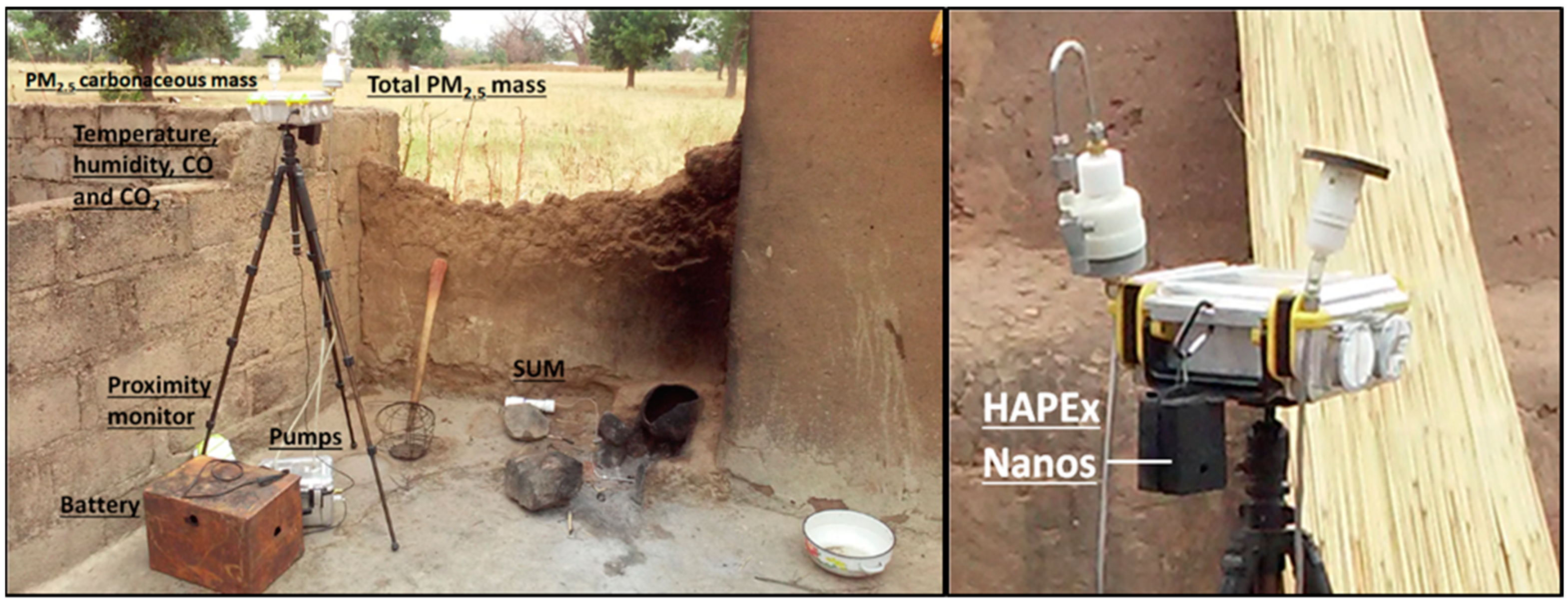
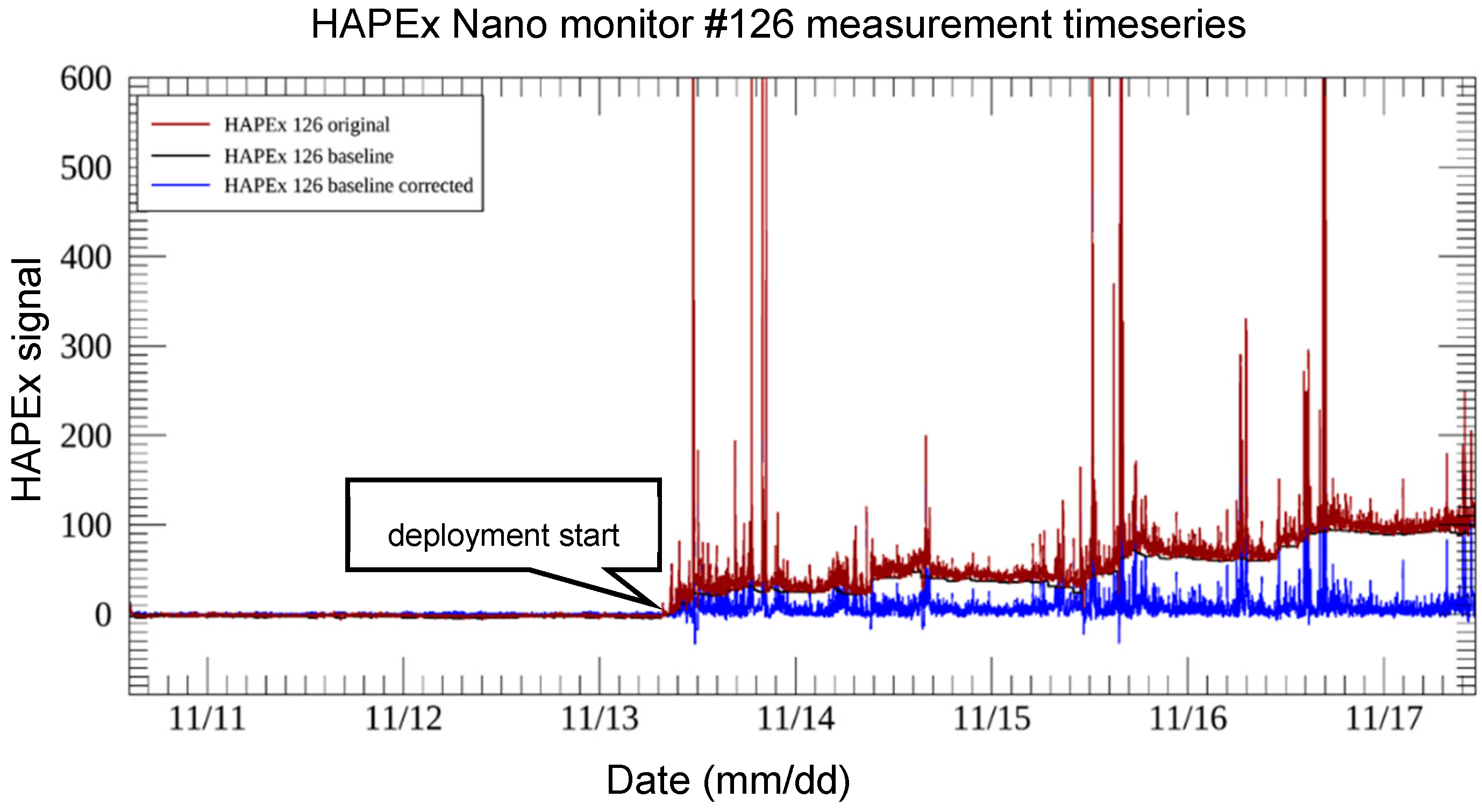
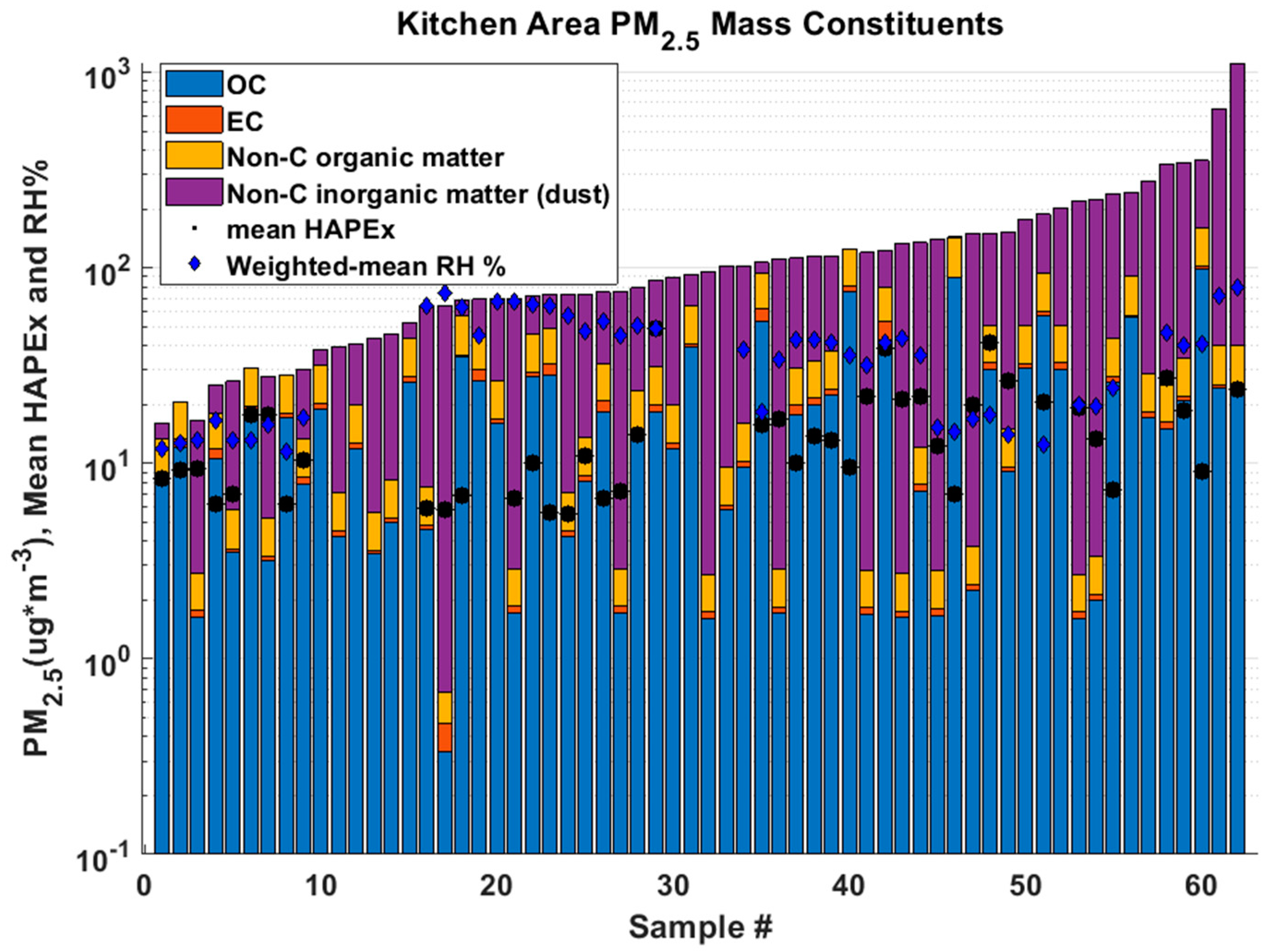
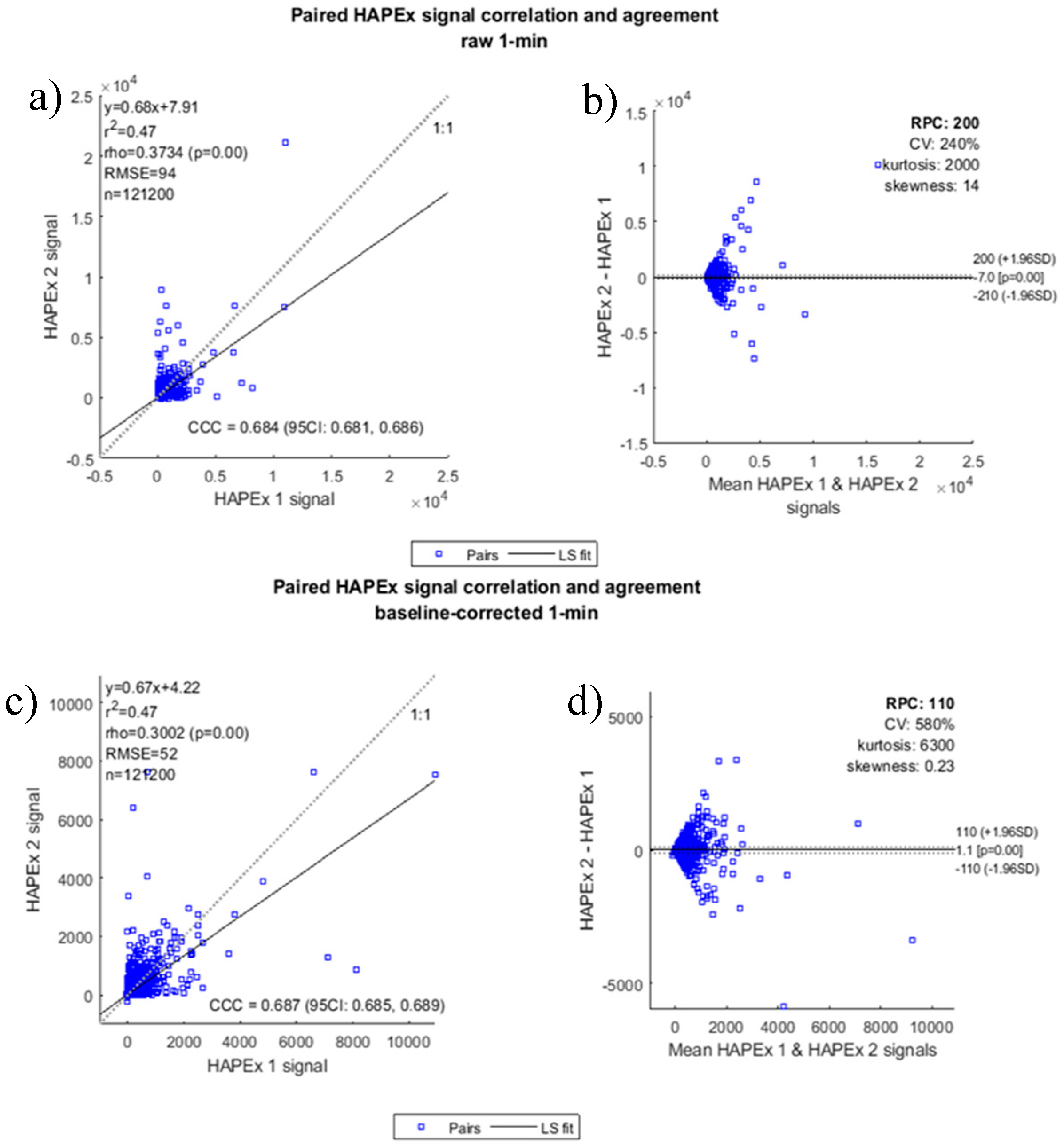
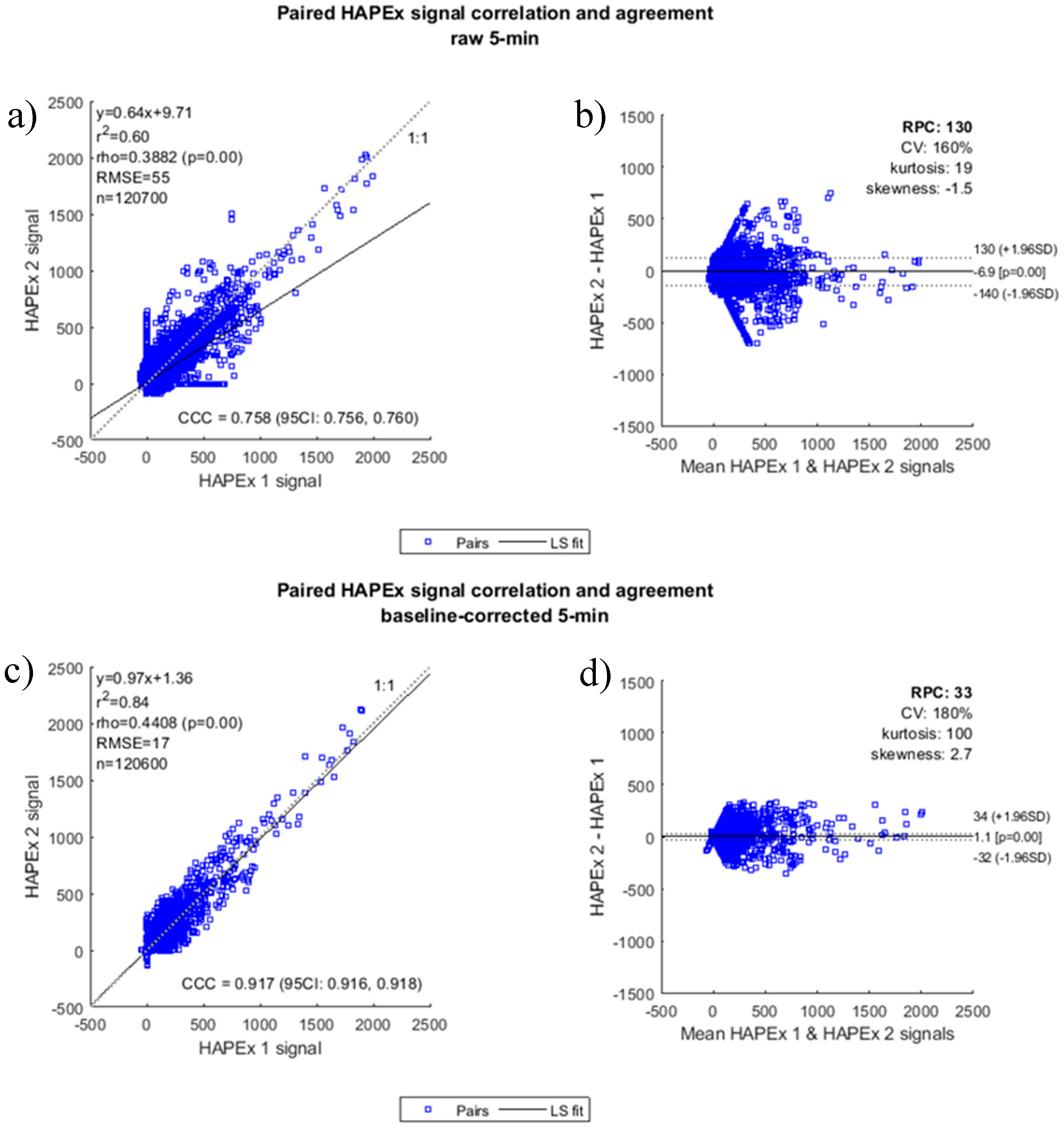
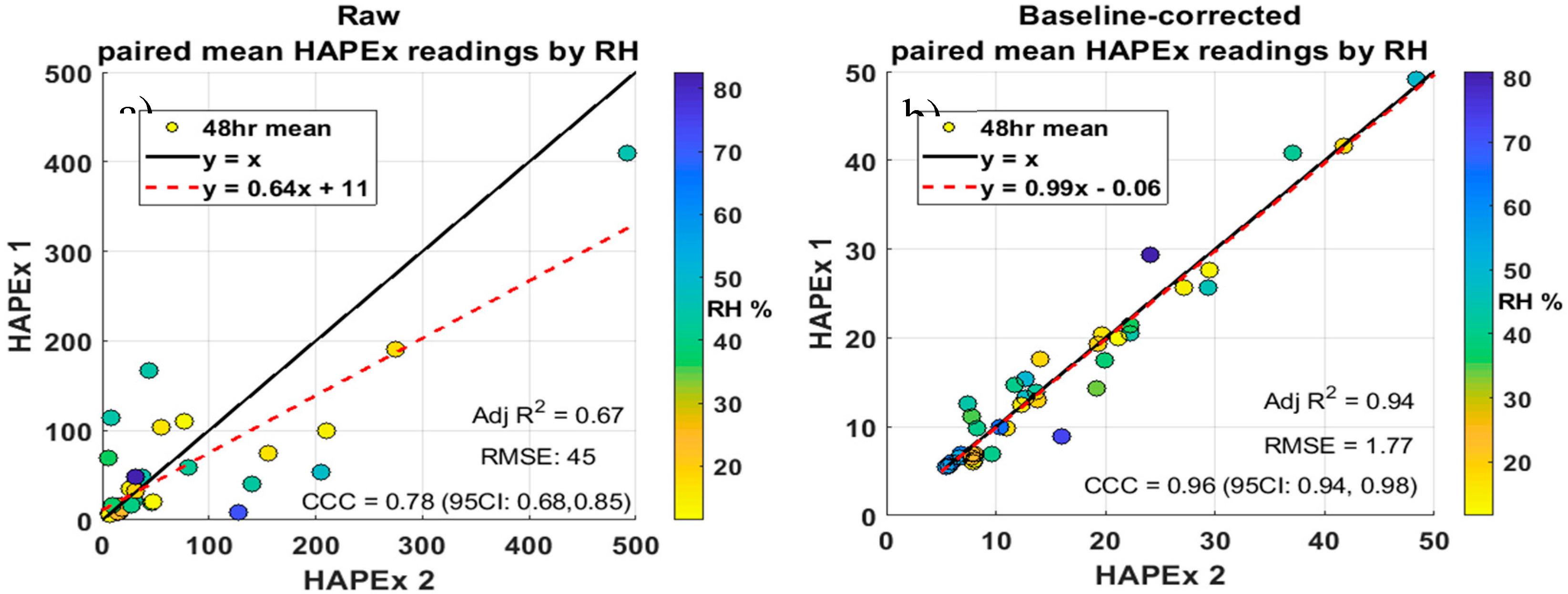
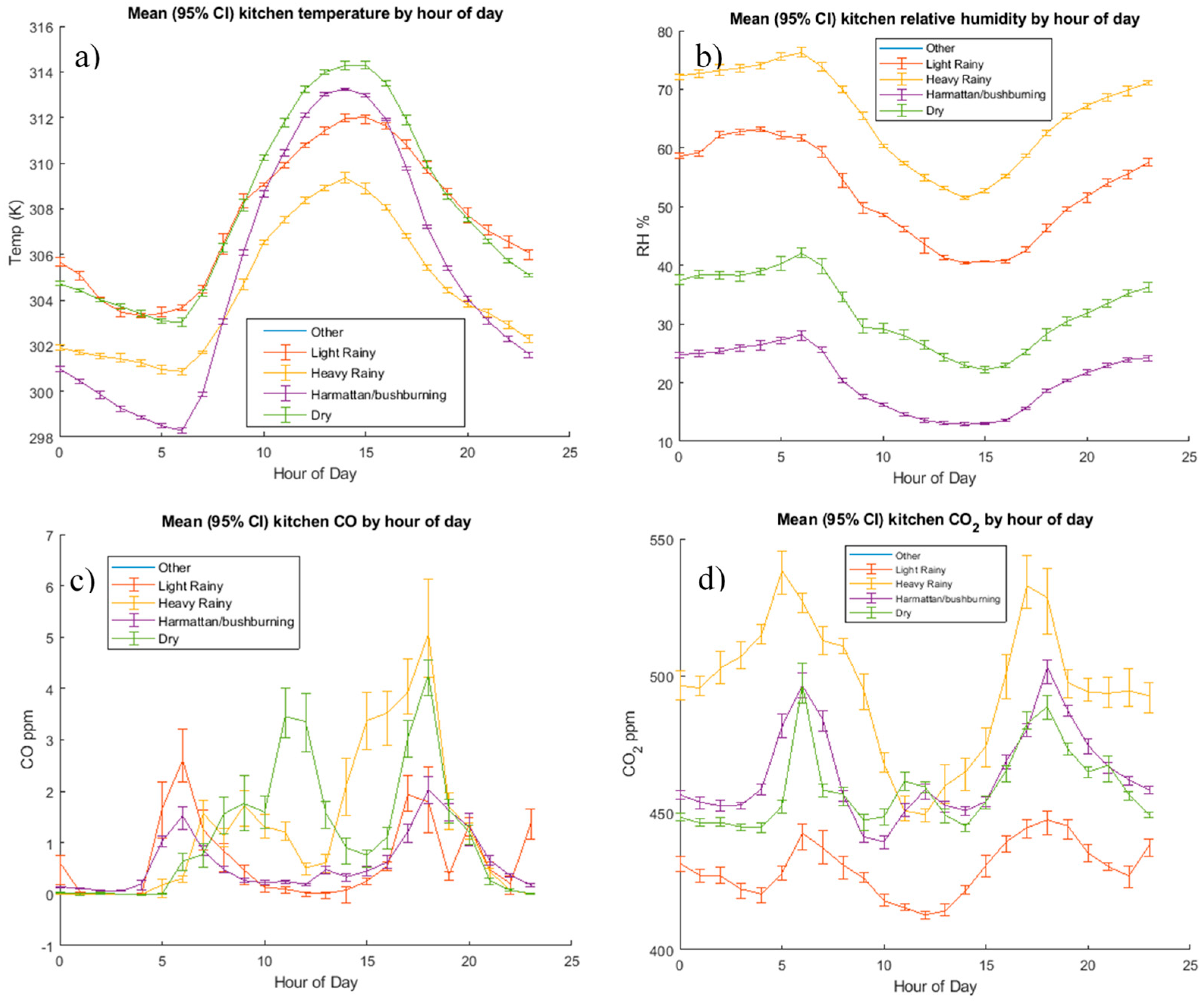
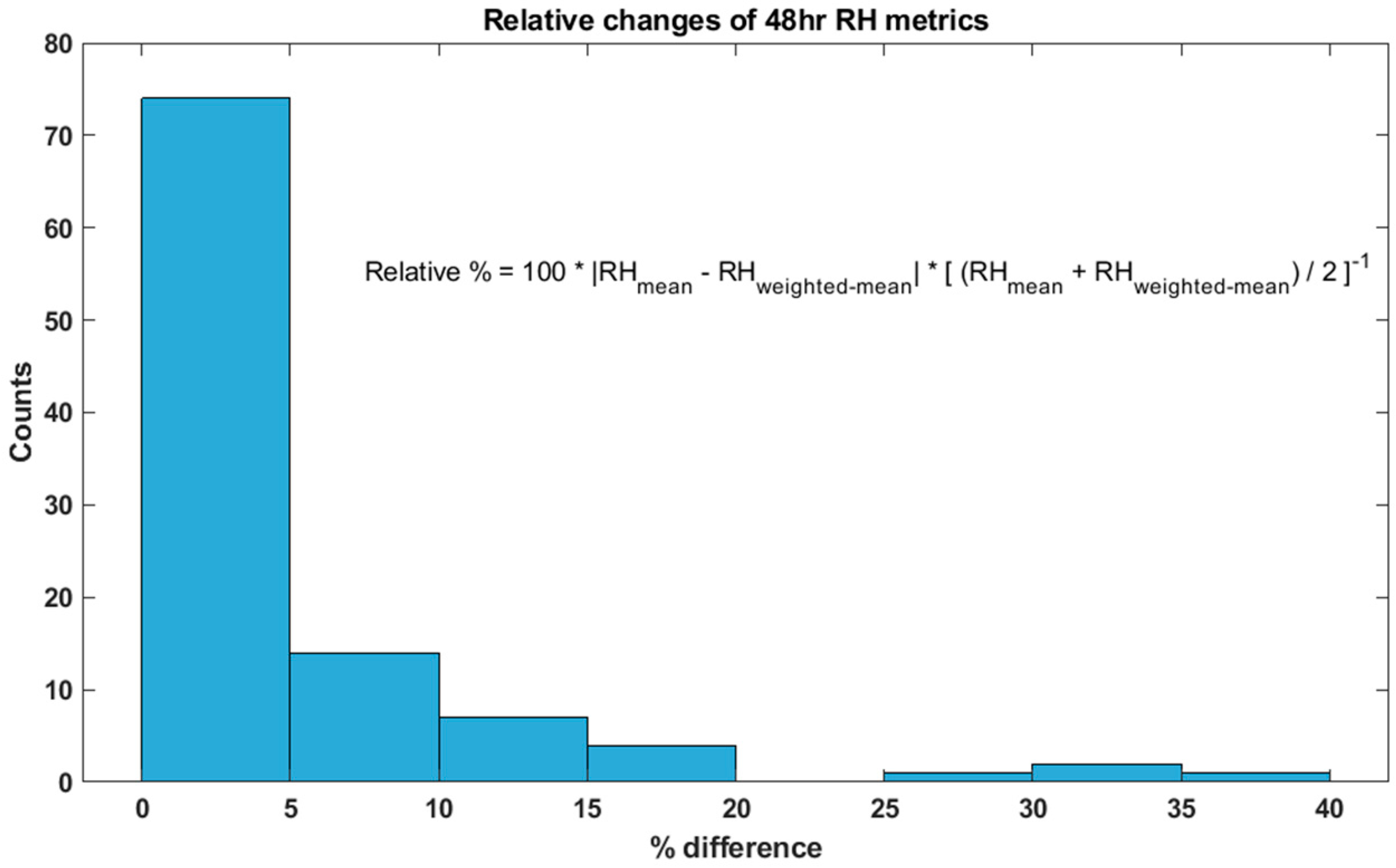
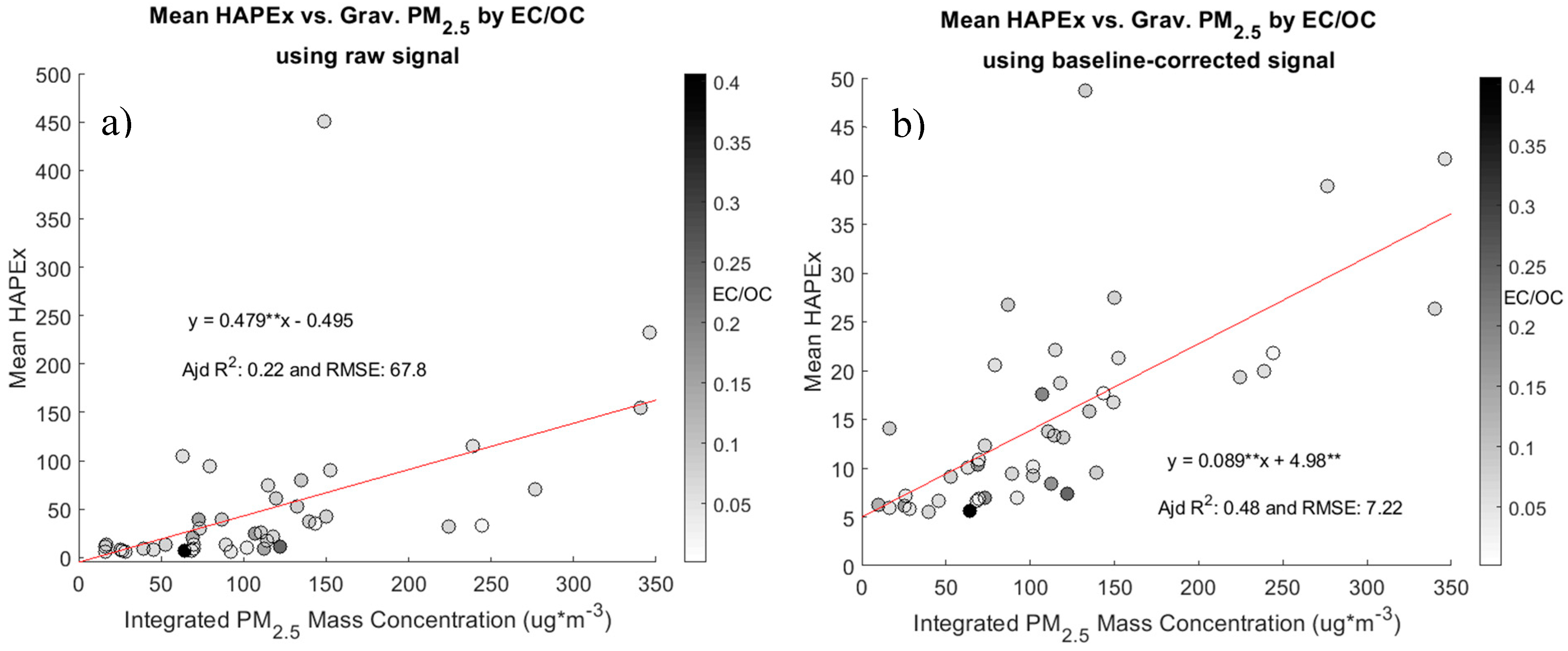
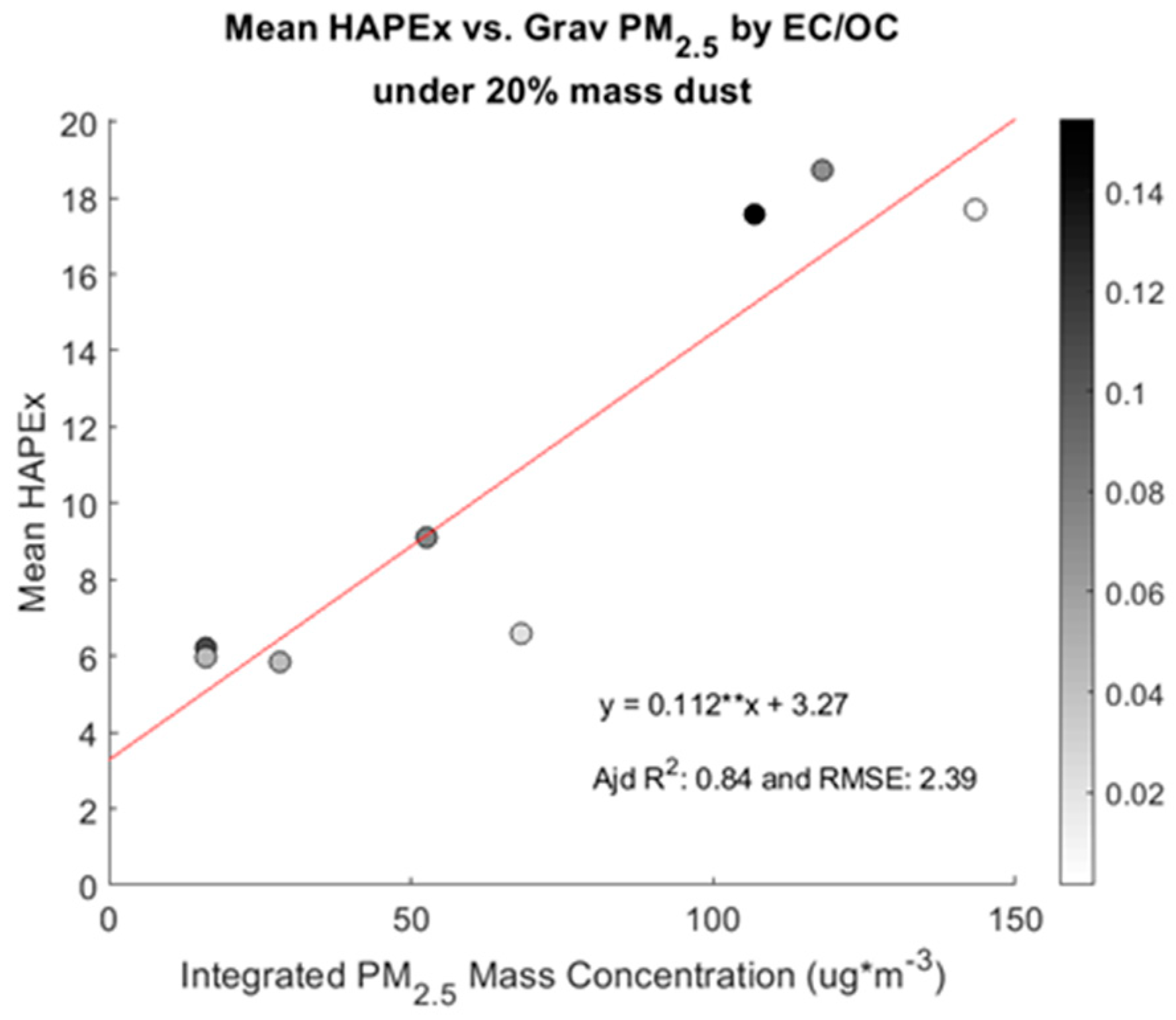
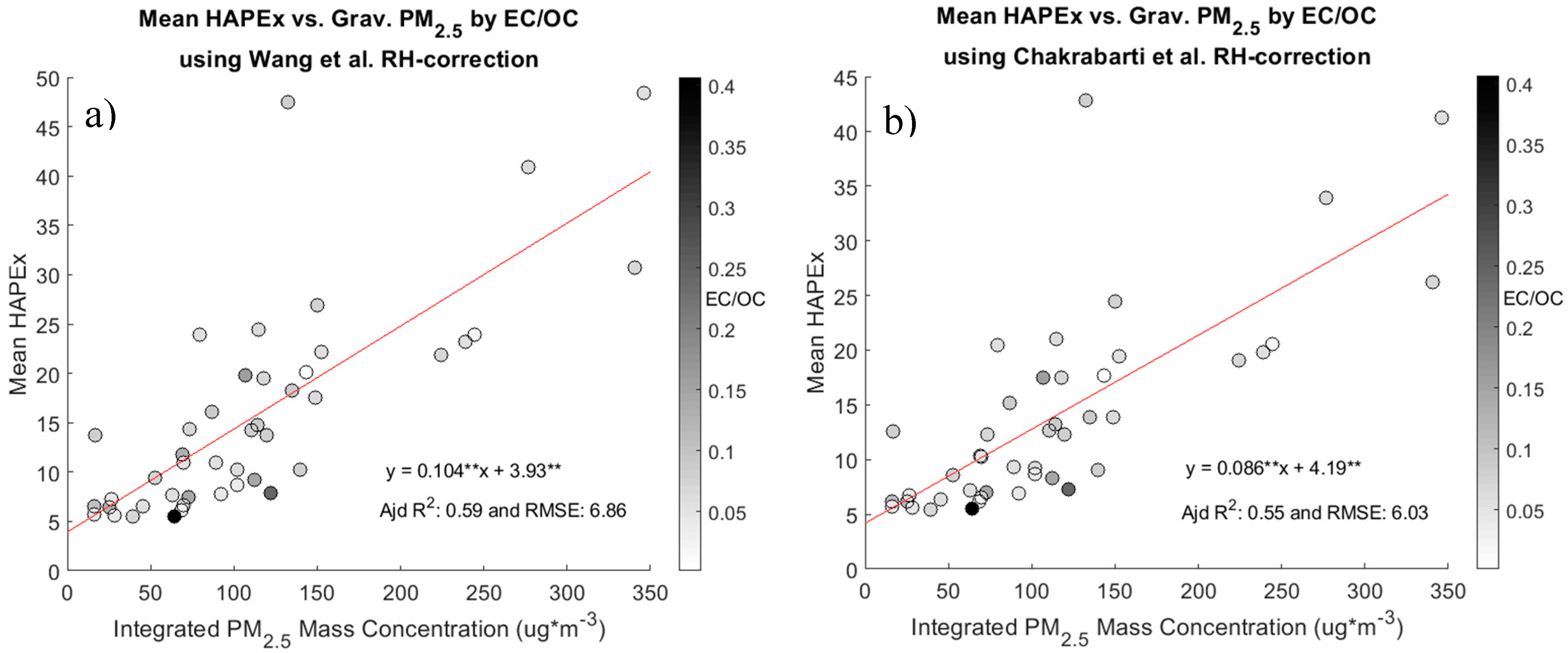
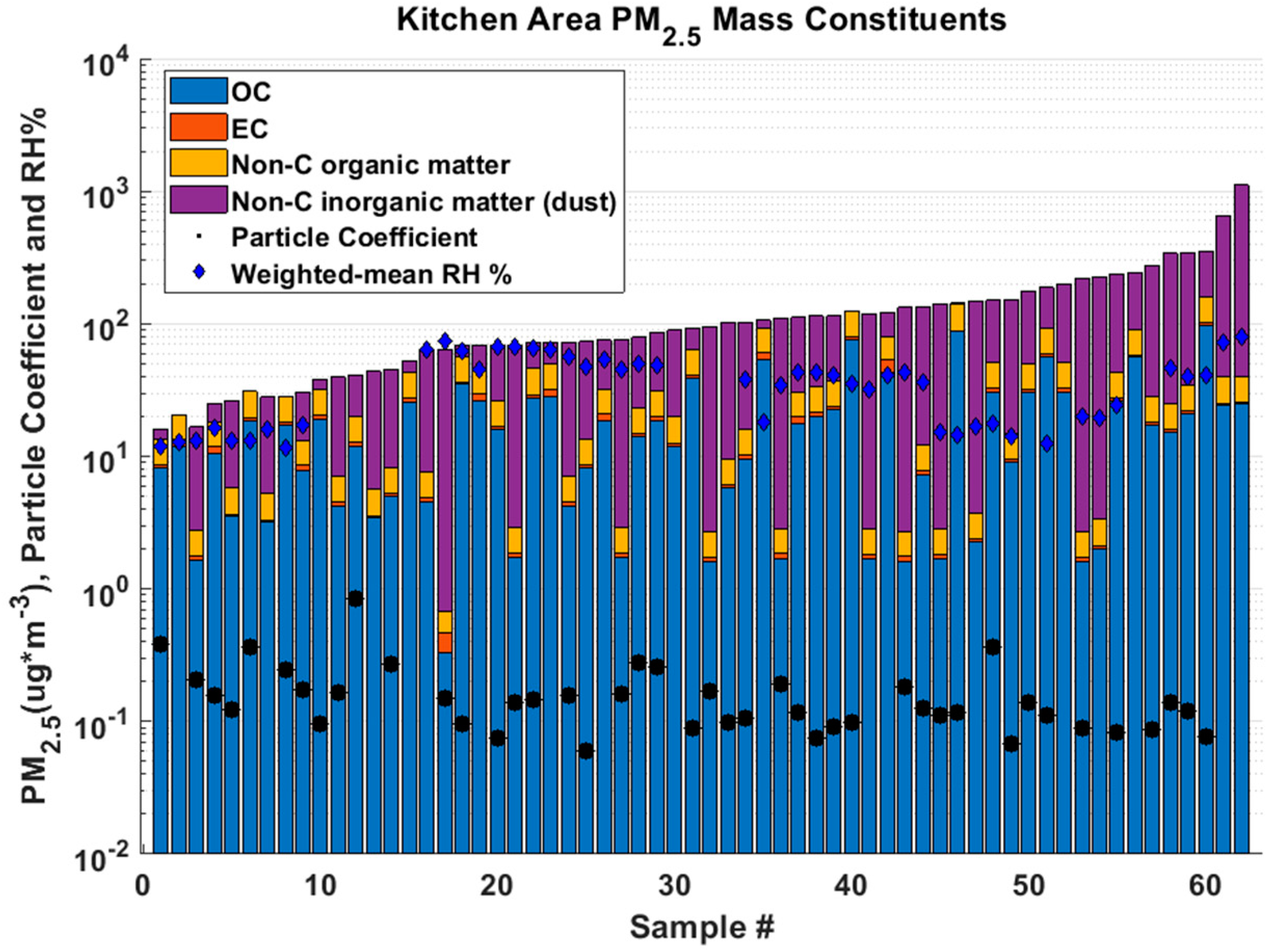
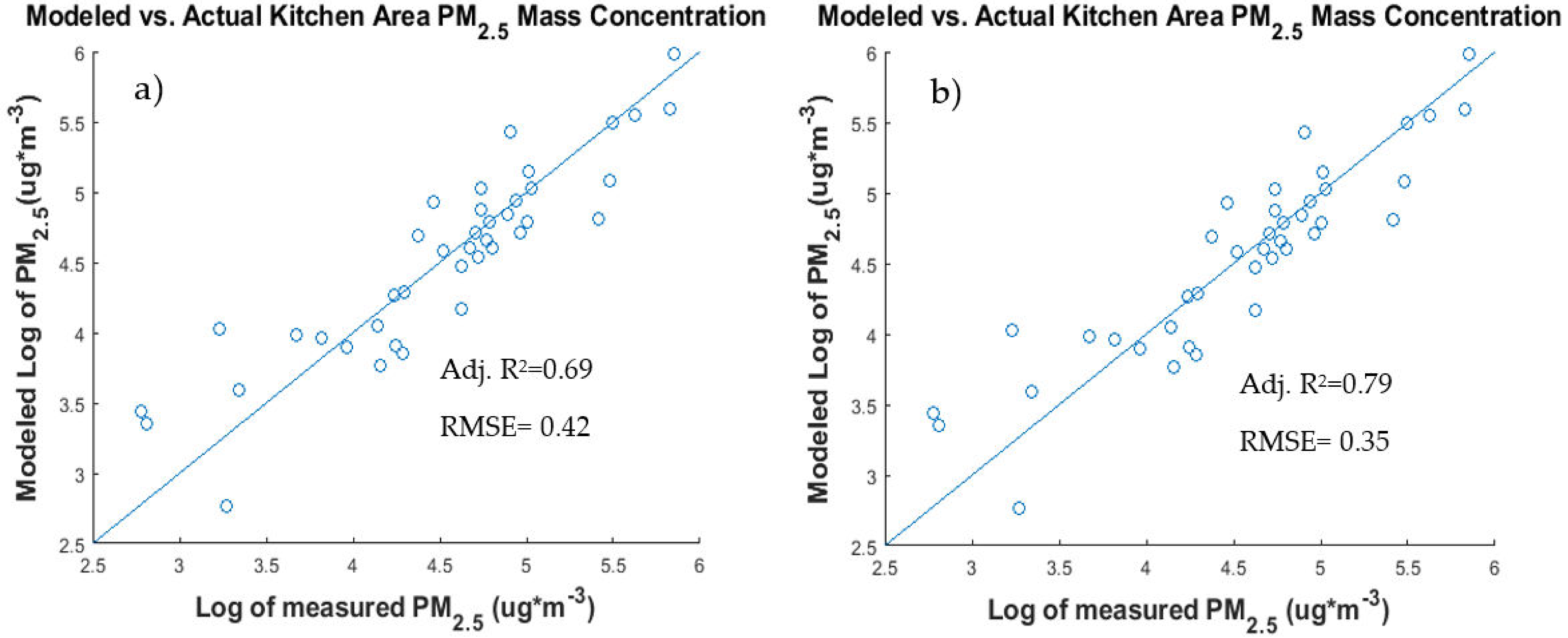
| Criterion | PM2.5 > 75 μg∙m−3 | PM2.5 > 50 μg∙m−3 | PM2.5 > 37.5 μg∙m−3 | PM2.5 > 25 μg∙m−3 |
|---|---|---|---|---|
| WHO 24-h metric | IT-1 | IT-2 | IT-3 | AQG |
| Rural | 84% (21/25) | 100% (25/25) | 100% (25/25) | 100% (25/25) |
| Urban | 43% (16/37) | 62% (23/37) | 76% (28/37) | 92% (34/37) |
| Overall | 60% (37/62) | 77% (48/62) | 85% (53/62) | 95% (59/62) |
| Criterion | PM2.5,dust > 75 μg∙m−3 | PM2.5,dust > 50 μg∙m−3 | PM2.5,dust > 37.5 μg∙m−3 | PM2.5,dust > 25 μg∙m−3 |
|---|---|---|---|---|
| WHO 24-h metric | IT-1 | IT-2 | IT-3 | AQG |
| Rural | 68% (17/25) | 84% (21/25) | 88% (22/25) | 92% (23/25) |
| Urban | 27% (10/37) | 41% (15/37) | 49% (18/37) | 57% (21/37) |
| Overall | 44% (27/62) | 58% (36/62) | 65% (40/62) | 71% (44/62) |
| Model Coefficients | b(0), a | b(1), b | b(2) | b(3) | p | Adj. R2 | RMSE |
|---|---|---|---|---|---|---|---|
| Equation (2) (mean RH) | 0.117 * | 0.001 | - | - | - | 0.02 | 0.13 |
| Equation (3) (HAPEx-weighted RH) | 0.115 * | 0.002 | - | - | - | 0.03 | 0.13 |
| Equation (4) (logarithmic) | 3.75 * | −0.18 | - | - | - | 0.05 | 0.36 |
| Equation (5) (nonlinear) | 0.153 * | 0.037 | - | - | - | 0.007 | 0.13 |
| Equation (6) (multilinear) | 0.112 | - | - | - | 0.005 | 0.79 | 0.061 |
| meanHAPEx | 0.007 | - | - | - | 0.09 | ||
| dust_concentration | −9 × 10−4 | - | - | - | 0.10 | ||
| Location_Type: rural | Reference Group | ||||||
| Location_Type: urban | 0.12 | - | - | - | 0.03 | ||
| meanHAPEx: season_Dry | Reference Group | ||||||
| meanHAPEx: season_Harmattan_bushburning | - | −0.001 | - | - | 0.80 | ||
| meanHAPEx: season_Heavy_Rainy | - | 0.005 | - | - | 0.33 | ||
| meanHAPEx: season_Light_Rainy | - | 0.07 | - | - | 0.00 | ||
| meanHAPEx: season_other | - | 0 | - | - | NA | ||
| dust_concentration: season_Dry | Reference Group | ||||||
| dust_concentration: season_Harmattan_bushburning | - | - | 0.0002 | - | 0.71 | ||
| dust_concentration: season_Heavy_Rainy | - | - | −0.001 | - | 0.17 | ||
| dust_concentration: season_Light_Rainy | - | - | −0.022 | - | 0.00 | ||
| dust_concentration: season_other | - | - | 0 | - | NA | ||
| meanHAPEx: LocationType_Rural | Reference Group | ||||||
| meanHAPEx: LocationType_Urban | - | - | - | −0.01 | 0.01 | ||
© 2019 by the authors. Licensee MDPI, Basel, Switzerland. This article is an open access article distributed under the terms and conditions of the Creative Commons Attribution (CC BY) license (http://creativecommons.org/licenses/by/4.0/).
Share and Cite
Coffey, E.R.; Pfotenhauer, D.; Mukherjee, A.; Agao, D.; Moro, A.; Dalaba, M.; Begay, T.; Banacos, N.; Oduro, A.; Dickinson, K.L.; et al. Kitchen Area Air Quality Measurements in Northern Ghana: Evaluating the Performance of a Low-Cost Particulate Sensor within a Household Energy Study. Atmosphere 2019, 10, 400. https://doi.org/10.3390/atmos10070400
Coffey ER, Pfotenhauer D, Mukherjee A, Agao D, Moro A, Dalaba M, Begay T, Banacos N, Oduro A, Dickinson KL, et al. Kitchen Area Air Quality Measurements in Northern Ghana: Evaluating the Performance of a Low-Cost Particulate Sensor within a Household Energy Study. Atmosphere. 2019; 10(7):400. https://doi.org/10.3390/atmos10070400
Chicago/Turabian StyleCoffey, Evan R., David Pfotenhauer, Anondo Mukherjee, Desmond Agao, Ali Moro, Maxwell Dalaba, Taylor Begay, Natalie Banacos, Abraham Oduro, Katherine L. Dickinson, and et al. 2019. "Kitchen Area Air Quality Measurements in Northern Ghana: Evaluating the Performance of a Low-Cost Particulate Sensor within a Household Energy Study" Atmosphere 10, no. 7: 400. https://doi.org/10.3390/atmos10070400
APA StyleCoffey, E. R., Pfotenhauer, D., Mukherjee, A., Agao, D., Moro, A., Dalaba, M., Begay, T., Banacos, N., Oduro, A., Dickinson, K. L., & Hannigan, M. P. (2019). Kitchen Area Air Quality Measurements in Northern Ghana: Evaluating the Performance of a Low-Cost Particulate Sensor within a Household Energy Study. Atmosphere, 10(7), 400. https://doi.org/10.3390/atmos10070400






